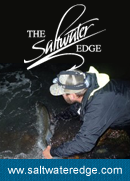Since the cold snap last Friday fishing has dramatically improved in SOME areas. Where there was just bait and desolate sand last week, beaches come alive as soon as the darkness falls. Does the time matter ? It usually does, but in my experience over the years, not so much in this particular type of bite.
(btw I am going to be totally upfront stating that this is happening on very few beaches that I know , most are still not producing. Do not want to make anyone think they are missing out on hot local action)
Why would I make such a preposterous statement when it goes against everyone we have been taught about structure, currents and particularly outgoing tide. The tide that is flushing out baitfish out of the inlets in fall , or moving them along the beach?
A lot of your juvenile or the young of the year bait will spend considerable time inside the inlets in confines of protected Bay areas. Naturally in the fall, they will flush out of the inlets on the outgoing tide and usually ride into the mouths of game fish that set up the station on the outside of these inlets. This is a natural occurrence that has been happening over and over and over for probably thousands of years. And it still holds true but the presence of sandeels as a primary bait kind of the disrupts this “fall dance”
There is no great mystery unearthed here, it has everything to do with migration patterns, and very little to do with my intelligence.
Unlike 99% of the bait fish which moves along our shores , east to west until they reach NJ and then head south along its shores, sand eels move in from deep water into shallow beach front where you can find them buried into sand. So they are not flushed out of inlets on outgoing tide and they are not moving along the beaches in big school like bunker or hearing
What does this mean for us?
I’ve written about this before and the only reason I am repeating this is because I see friends that are hitting places close to home which “should” be productive but they are not. They wait for fish to move into their area, but they never do. Next thing you know it’s November and fish have moved past their home grounds, and they missed out on their chance, something that they been waiting to participate with anticipation all year.
So this is simple advice but during times when fishing is really though (who are we kidding it sucks) and striped bass stocks are in trouble, you might have to break few of your personal rules and go where the fish are. Because chances of them coming to your beach are slim if sand eels are the primarily bait. Remember that sand eel migrate from deep water into shallow, one of the primary reasons why boats can often do as well as surf anglers, especially when employing jigs. Which reminds me of a bloodbath we saw few years ago courtesy of South shore LI party boat fleet. It would be a shame if this happens again.
But anyway, that’s the message, go where you know the fish have been ( no, not where you read on fb or hearsay, knowing is not the same as thinking you know)
There are a lot of other baitfish mixed in with sand eels, as you can see in this picture Tommy sent me, peanut bunker, sand eel and while bait, all pushed out on the beach by bass…but you got to be in the right spot












I’ve been using tsunami sandeels for couple of months and they’ve been producing for me nothing big
↓Tommy’s hand looks really soft. Does he use special ‘hand cream’ to keep that ‘soft glow’? B
↓Irish Spring…. : )
↓Good article Z. A lot of people don’t understand the vertical migration habits of sandeels so they stay put west hoping “they will come this way” which of course never happens. There’s a few good spots and a few VERY good spots on Long Island where this sandeel bite is happening, you just gotta go there and cash in on it.
↓